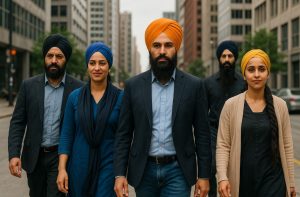Why do Sikhs let their hair grow naturally without cutting it? What religious or spiritual significance does this practice carry? For many, especially those outside the Sikh community, the sight of a Sikh man or woman with uncut hair wrapped in a turban is both distinctive and symbolic but not everyone understands the deeper reasons behind it.
In Sikhism, keeping hair uncut is not simply a matter of tradition or style. Known as Kesh, this practice is a fundamental expression of faith, devotion, and spiritual discipline.
It is one of the Five Ks, the articles of faith that represent a Sikh’s dedication to the teachings of the Gurus and the path laid out for the Khalsa, the collective of initiated Sikhs.
This blog explores in depth why Sikhs do not cut their hair, uncovering the historical, theological, cultural, and spiritual significance of Kesh in Sikh identity.
What Is the Religious Meaning Behind Uncut Hair in Sikhism?

The practice of keeping uncut hair in Sikhism originates from the belief that the human body is a divine creation. Sikhs hold the view that everything given by God, including hair, is purposeful and should be preserved as it is. Cutting or altering the body, including trimming hair, is seen as interfering with divine design.
This belief is rooted in the concept of Hukam, or divine will. According to Sikh teachings, living in alignment with Hukam means accepting and respecting God’s decisions including one’s natural physical form. Thus, allowing hair to grow freely is a direct expression of this acceptance.
Moreover, Kesh is not just a matter of external appearance. It is part of a larger spiritual discipline that encourages humility, patience, and self-restraint all values essential to the Sikh way of life.
Why Did Guru Gobind Singh Make Kesh One of the Five Ks?
In 1699, Guru Gobind Singh Ji, the tenth Guru of Sikhism, formally established the Khalsa, a spiritual brotherhood of initiated Sikhs committed to living a life of service, righteousness, and discipline.
During the first Khalsa initiation ceremony at Anandpur Sahib, he introduced the Five Ks (Panj Kakar) five external symbols that every Khalsa Sikh must maintain.
Kesh was one of these articles of faith. Its inclusion was not arbitrary. Guru Gobind Singh viewed uncut hair as a mark of courage, strength, and spiritual discipline. It served both as a commitment to God and as a symbolic separation from social customs that encouraged grooming based on caste or vanity.
By mandating Kesh, Guru Gobind Singh reinforced the idea that Sikhs should live fearlessly, naturally, and in accordance with spiritual rather than worldly standards.
How Does Kesh Reflect the Sikh Belief in Accepting God’s Will?
In Sikh philosophy, the concept of submission to divine will is central. Every Sikh is encouraged to accept life’s circumstances as the unfolding of God’s plan. This includes accepting one’s body in its natural state.
Kesh is one of the most practical demonstrations of this belief. It represents a deep level of surrender choosing not to manipulate or alter what has been gifted by the Creator.
Just as one would not question the rising of the sun or the changing of the seasons, Sikhs believe the human form should be left untouched, as a reflection of God’s perfection.
This acceptance also encourages a sense of humility. By resisting the societal pressure to modify appearance, Sikhs learn to prioritise inner values over outward vanity.
How Does Uncut Hair Serve as a Visible Symbol of Faith?

In a diverse world, symbols matter. For Sikhs, Kesh is a highly visible expression of religious identity. Alongside the turban, which is often worn to protect and cover the uncut hair, it allows Sikhs to be instantly recognisable, not just to others, but to themselves.
This visibility has practical and spiritual implications. Practically, it creates a strong group identity and a sense of belonging. Spiritually, it serves as a reminder of one’s responsibilities, both to God and to the Sikh community.
Being identifiable also means Sikhs are often held to higher standards, both by themselves and others. This can create a positive pressure to act ethically, represent their faith with integrity, and live a principled life.
Is There a Spiritual or Energetic Aspect to Keeping Hair Uncut?
While not a formal doctrine, some Sikhs believe that hair plays a role in maintaining spiritual energy. In particular, the practice of tying the hair in a bun at the top of the head near the crown chakra is thought to assist in the concentration of spiritual energy, especially during meditation or prayer.
This belief is more commonly found among spiritual seekers within Sikhism who emphasise internal energy flow and mindfulness. The hair is seen as a kind of spiritual antenna, helping to channel energy from the cosmos through the body and into action.
Whether one embraces this metaphysical perspective or not, the discipline of maintaining uncut hair washing it, combing it, tying it carefully, promotes mindfulness and regular care for the body, aligning with Sikh values of cleanliness and self-respect.
How Does Kesh Promote Equality and Reject Social Hierarchies?
Before the emergence of Sikhism, hair cutting and shaving were sometimes associated with social oppression or caste-based customs.
For example, members of lower castes were occasionally forced to shave their heads as a sign of subjugation. By contrast, Sikhism which emerged as a rebellion against such injustices, uplifted dignity and equality through the preservation of natural hair.
Guru Gobind Singh’s declaration that all Khalsa Sikhs must keep uncut hair was also a political and social statement. It rejected not only the caste system but also the ritualistic practices of other religions that focused on outward appearance as a sign of piety.
In this way, Kesh became a powerful equaliser. Regardless of one’s birth, background, or social standing, every Khalsa Sikh was to maintain the same physical markers of identity asserting that all are equal before God.
How Does Sikhism’s View of Hair Differ from Other Religions?
Religious attitudes towards hair vary significantly across different faiths. While some see it as a sacred element to be preserved, others regard it as something to be removed or stylised for specific purposes.
Here’s a comparison to illustrate the different approaches:
| Religion | Hair Practices | Religious or Spiritual Significance |
| Sikhism | Hair must remain uncut | Symbol of divine acceptance, discipline, and identity |
| Islam | Beard encouraged, head hair maintained or trimmed | Expression of cleanliness and respect for Sunnah |
| Christianity | Varies by denomination | In some sects, long hair is symbolic of obedience (e.g., nuns) |
| Hinduism | Hair shaved during rituals | Part of purification, renunciation, and transition |
| Buddhism | Monks shave their heads | Symbol of detachment from worldly attachments |
Sikhism stands out by making uncut hair a universal expectation for initiated followers, integrating it deeply into both everyday life and spiritual purpose.
What Role Does Kesh Play in Modern Sikh Identity?

In today’s world, the visibility of Kesh carries both blessings and burdens. In multicultural societies like the UK, Sikhs with uncut hair and turbans are often recognised but sometimes misunderstood. This visibility can lead to both positive representation and negative stereotyping.
Young Sikhs, especially in Western contexts, may feel social or professional pressure to conform to mainstream beauty standards. However, many continue to uphold the tradition of Kesh with pride and resilience, often engaging in advocacy or education to inform others about the meaning behind their appearance.
In response, Sikh organisations have developed outreach programmes, school presentations, and online resources to promote understanding. By embracing and explaining their identity, Sikhs help to build bridges across communities and preserve the depth of their tradition in a modern context.
What Happens If a Sikh Chooses to Cut Their Hair?
Sikhism promotes compassion, personal growth, and internal transformation. While cutting hair is discouraged, especially for Amritdhari Sikhs (those who have undergone initiation), it does not result in exclusion from the community.
However, it may signify a departure from the full Khalsa discipline, and individuals who cut their hair may not be considered in full alignment with Khalsa principles.
That said, the focus in Sikhism is always on intention, humility, and willingness to learn. Many Sikhs who choose to return to keeping Kesh are fully welcomed and supported by the community.
Conclusion: Why Do Sikhs Not Cut Their Hair?
The question of why Sikhs do not cut their hair can only be fully understood through the lens of Sikh philosophy, history, and identity. It is not a superficial choice, nor is it merely a tradition carried over from the past.
Rather, it is a profound act of spiritual devotion, a visible expression of the Khalsa path, and a constant reminder of the values that Sikhs hold dear.
Kesh teaches acceptance of God’s will, encourages discipline, symbolises equality, and establishes a strong sense of identity. Whether maintained in a small village in Punjab or a bustling city in the UK, uncut hair continues to connect Sikhs across generations to their Gurus, their community, and their Creator.
FAQs About Sikh Hair Practices
What does Kesh represent in Sikhism?
Kesh represents a Sikh’s commitment to God’s will, spiritual discipline, and the teachings of Guru Gobind Singh. It reflects acceptance of natural form and devotion to the Khalsa path.
Do all Sikhs keep uncut hair?
While all Sikhs are encouraged to maintain Kesh, it is a strict requirement for Amritdhari Sikhs. Some cultural and generational differences may influence adherence.
Why do Sikh women also keep their hair uncut?
Sikhism teaches gender equality. Both men and women are expected to maintain unshorn hair as part of the Five Ks.
Is it acceptable to cut hair for medical reasons?
Yes. Sikhism prioritises life and health, so cutting hair for medical treatment is permitted and does not violate spiritual principles.
What is the significance of the turban in relation to Kesh?
The turban protects and honours uncut hair. It also adds dignity to the wearer and represents responsibility and identity within the Sikh community.
How are young Sikhs taught the importance of Kesh?
Through family teachings, Gurdwara classes, community mentorship, and participation in religious ceremonies, children learn the spiritual value of Kesh.
Can someone return to Sikh discipline after cutting their hair?
Yes. Sikhism encourages personal growth and return to discipline. Many Sikhs choose to recommit to Kesh later in life and are embraced by the community.
READ NEXT:






